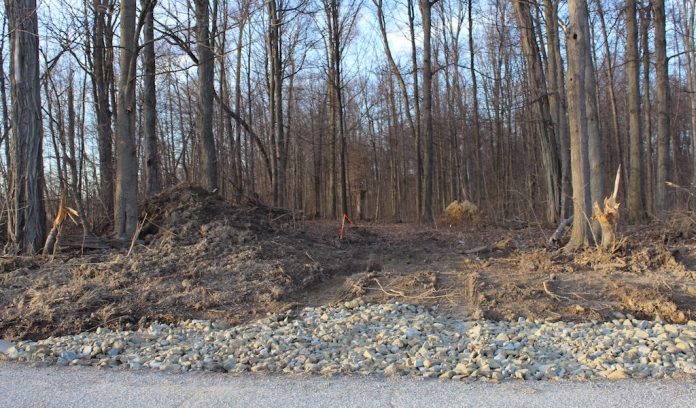WOOSTER, Ohio — The Ohio Environmental Protection Agency will hold an informational meeting and hearing to discuss the permit-to-install application for the Wiles Storage Pond, April 17 at the Ohio Agricultural Research and Development Center in Wooster.
The 10 million gallon structure is intended to hold anaerobically digested municipal waste and biosolids after they leave the Quasar Energy plant at the OARDC in Wooster. The material would later be land applied to EPA-approved fields.
The information session will begin at 6 p.m. at Fisher Auditorium, 1680 Madison Avenue, Wooster. A hearing will follow to provide an opportunity for the public to submit comments on the permit application.
Buckeye Biogas, a subsidiary of Quasar, is proposing to build its lagoon in Canaan Township, Wayne County, east of the intersection of Friendsville and East Pleasant Home Road.
Concerned residents
The project has drawn the attention of local residents and some farmers, who are concerned about the potential for environmental impact, decreased home values and odor.
Supporters of the project say it’s an EPA-approved product that is good for the soil, amounting to another form of organic fertilizer.
A Ohio EPA spokesperson said the public does not have to submit questions or comments before the meeting. However, if there is a large volume of comments, the EPA staff may ask people to write their question on an index card, which will be provided. Similar questions are then grouped, in the interest of time.
The spokesperson said there is typically an informal question-and-answer session following staff presentations, followed by the hearing.
The EPA reviews the comments following the meeting, and responses are issued in the following weeks.
The EPA will accept written comments on the permit application through April 24. Anyone can submit comments or request to be on the mailing list for information.
To comment or receive information on the permit application, write to: Ohio EPA-DSW, Permits Processing Unit, P.O. Box 1049, Columbus, OH 43216-1049 or email epa.dswcomments@epa.ohio.gov. Write the PTI permit number 1211412 on each comment sent.
Related coverage:
- Wiles lagoon stirs debate in Wayne County (March 1, 2018).
- Wayne County residents oppose waste lagoon (March 15, 2018).
- What are biosolids and are they safe? (March 20, 2018).











Ohio EPA need to read more and farmer need to look at all the facts not just the ones coming from the multibillion dollar sewage industry who have made suckers out of many farmers using incomplete data and money as the suckers hook.
**Every US industry connected to a sewer can discharge any amount of hazardous and acute hazardous waste into sewage treatment plants as long as they report it. Yeow right! There are over 80,000 chemicals in commerce and growing even today. It ends up in biosolids which is broadcasted over forest, farms and even bags taken to the consumer’s home and used in their garden
**US EPA Office Inspector General (OIG) Report # 14-P-0363 in 09/2014 / Google and read it for yourself. To sum up, industrial pre-treatment is not working and has never worked and nothing has been done about it. It ends up in biosolids and sewage plant effluent. “The priority pollutants list has not been updated since 1981”
**So when you hear anyone from the multi-billion dollar sewage industry or anyone with monetary ties to any part of the sewage industry say the chemicals in biosolids are minimal and inconsequential or that they support composting with biosolids, ask them for any test showing the degree of hazard and concentrations of 80,000 chemicals that are found in biosolids or a composted biosolids like Milorganite from Milwaukee.
**Chemicals that are persistent in the environment, bio-accumulate in people and/or wildlife, and are toxic are called Persistent, bioaccumulative and toxic substances (PBTs). With more than 80,000 chemicals being injected into our environment you and your family are at considerable risk of exposure. As long as they remain in commerce and may therefore be released into the environment, they will threaten the health of humans, wildlife including aquatic life.
Cancer, Chronic Diseases, Birth Defect AND ALGAL BLOOMS !
Here is a list of a few ‘things’ that the NC Dept of Health and Human Services found in sewage sludge AKA “BIOSOLIDS”:
Halogenated volatiles:1,4-Dichlorobenzene, cis-1,2-Dichloroethylene, Dichloromethane, Tetrachloroethylene; Non-halogenated volatiles:Toluene, Meta- and para-xylene, Ortho-xylene,Total xylenes (calculated), Volatile petroleum hydrocarbons; Base-neutral extractables: Benzyl butyl phthalate, Bis(2-ethylhexyl) phthalate, Di-n-butyl phthalate,
Diethyl phthalate, Dimethyl phthalate; olycyclic aromatic hydrocarbons: Acenaphthene, Acenaphthylene, Anthracene,
Benz(a)anthracene, Benzo(a)pyrene, Benzo(b)fluoranthene, Benzo(g,h,i)perylene, Benzo(k)fluoranthene, Fluoranthene, Fluorene, Indeno(1,2,3-c,d)pyrene, Naphthalene, Phenanthrene, Pyrene; Chlorinated and… nonchlorinated phenolics: 4-Chloro-3-methylphenol, 2,4 and 2,5 Dichlorophenol, 3,4,5-Trichlorophenol, 2,3,4,5-Tetrachlorophenol, 2,3,4,6-Tetrachlorophenol, Pentachlorophenol, m-Cresol, o-Cresol, p-Cresol, 2,4-Dimethylphenol,
2-Nitrophenol, 4-Nitrophenol, Phenol; Extractables: Light extractable petroleum, Hydrocarbons (LEPHs),
Heavy extractable petroleum, Hydrocarbons (HEPHs); Dioxins: 2,3,7,8-TCDD, TCDD – Total, 1,2,3,7,8-PCDD, PCDD – Total, 1,2,3,4,7,8-HexCDD, 1,2,3,6,7,8-HexCDD, 1,2,3,7,8,9-HexCDD, HexCDD – Total, 1,2,3,4,6,7,8-HCDD, HCDD – Total, OCDD – Total; Furans: 2,3,7,8-TCDF, TCDF – Total, 1,2,3,7,8-PCDF, 2,3,4,7,8-PCDF, PCDF – Total, 1,2,3,4,7,8-HexCDF, 1,2,3,6,7,8-HexCDF, 2,3,4,6,7,8-HexCDF, 1,2,3,4,7,8,9-HexCDF, HexCDF – Total, 1,2,3,4,6,7,8-HCDF, 1,2,3,4,7,8,9-HCDF, HCDF – Total, OCDF – Total; PCDDF’s TEQs: 2,3,7,8-TCDD TEQs, 2,3,7,8-TCDD TEQs; Metals/Inorganic Chemicals: Arsenic, Barium, Cadmium, Chromium, Cobalt, Copper, Lead, Molybdenum, Nickel, Selenium, Silver, Tin,Zinc; Carcinogens (suspected and confirmed animal and human):
Aldrin, Arsenic, Benzene, Benzo(a)pyrene, Beryllium, Asbestos, Bis(2-ethylhexyl)phthalate, Benzo(a)anthracene, Benzidine, Benzo(b)fluoranthene, Benzo(k)fluoranthene, Cadmium, Chlordane, Chloroform, Chrysene, Chromium VI, Creosote, Chrysene, Dimethyl nitrosamine, Dioxin, DDD, DDE, DDT, Dibenzo(a,h)anthracene, Dieldrin, Dimethyl nitrosamine, 1,2 Dichloroethane, 1,2,Dibromoethane, Heptachlor, Indeno(1,2,3-c,d)pyrene, Lead, Lindane, Methylene chloride, Nickel, PCBs, Toxaphene, Trichloroethylene, Tetrachloroethene, 1,1,2,2,Tetrachloroethane; odorants: Hydrogen sulfide, Dimethyl sulfide, Diphenyl sulfide, Carbon disulfide, Dimethyl disulfide, Methyl mercaptan, Ethyl mercaptan, Propyl mercaptan, Allyl mercaptan, Benzyl mercaptan, Thiocresol, Ammonia, Methylamine, Dimethylamine, Trimethylamine, Ethylamine, Triethylamine, Pyridine, Indole, Scatole or Skatole, Acetic (ethanoic), Butyric (butanoic), Aldehydes & ketones Acetaldehyde; Bacteria: Salmonella, Shigella, Yersinia, Vibrio cholera, Campylobacter jejuni, Escherichia coli; viruses: Hepatitis A virus & E, Norwalk & Norwalk-like
Viruses, Rotaviruses, Enteroviruses, Polioviruses, Coxsackieviruses, Echoviruses, Reoviru, Astroviruses, Caliciviruses; protozoa: Cryptosporidium, Entamoeba histolytica, Giardia lamblia, Balantidium coli, Toxoplasma gondii; parasite worms: Ascaris lumbricoides, Ascaris suum, Trichuris trichiura, Toxocara canis, Taenia saginata, Taenia solium, Necator americanus, Hymenolepis nana